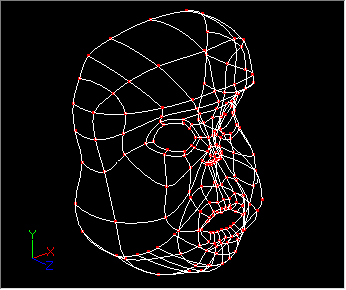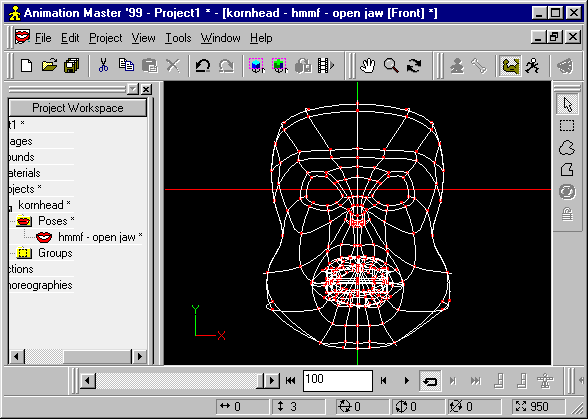
Also noticed that there aren't many tuts regarding pose sliders for AM99, esp for facial animation, so yet again, I step to the mic and present...
Pose Sliders
By Matt Estela
First, make sure your model is finished before you start defining poses. You can go in and tweak points after the fact, but if you do any major editing near any morphing areas, you'll be forced to go and tweak all of your poses again. Not difficult, but it is a time waster.
Group your model into managable segments, like face, lips, teeth, eyes, etc. Here's the full model:

And here's the face group:

According to Bay Raitt's fantastic site there's only a few poses you should really need to cover the bulk of your lip sync needs. They are:
hmmf - open jaw ooo - eee happy - sad fff - pout
There are more for the eyes, but for now we'll stick with the mouth shapes. The first one we'll tackle is the
hmmf - open jaw
pose.
Right click on your model, and choose new->pose.

You'll be dropped into a pose window (similar to an action window). First thing you'll need to do is get into muscle mode. If you don't know the difference, skeletal mode (which you start in by default) will let you keyframe bones to set a pose, while muscle mode will let you keyframe control points. Because facial animation involves subtle movement of surfaces, we want muscle mode. Hit F7 to enter muscle mode. Oh, and before you go any further, name the pose "hmmf - open jaw".

Within a pose window, the frame scrubber has a slightly different function. Rather than moving within frames, it's now working like a percentage meter. At 100, that's what your pose will look like when it's 100% on, 0 is 0% (so therefore, you shouldn't really change anything at 0), and at -100, it's -100%.
You don't need to define a pose for -100, but it's handy for cutting down on the number of poses you'll define. If you have two facial extremes you know you'll never blend together (say a smile and a frown), then you can put one at 100%, and the other at -100%, and you've now got a pose which has double the functionality.